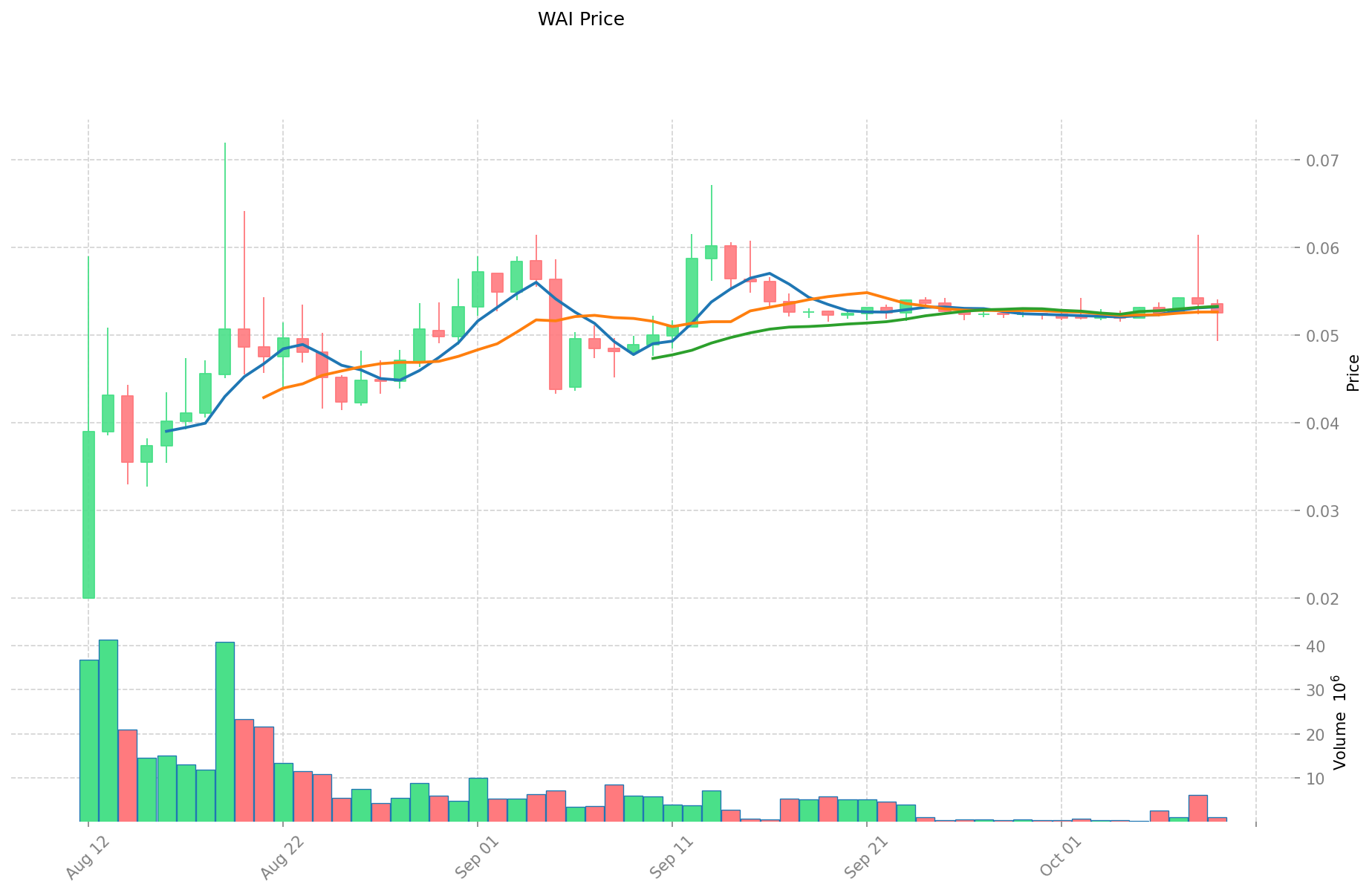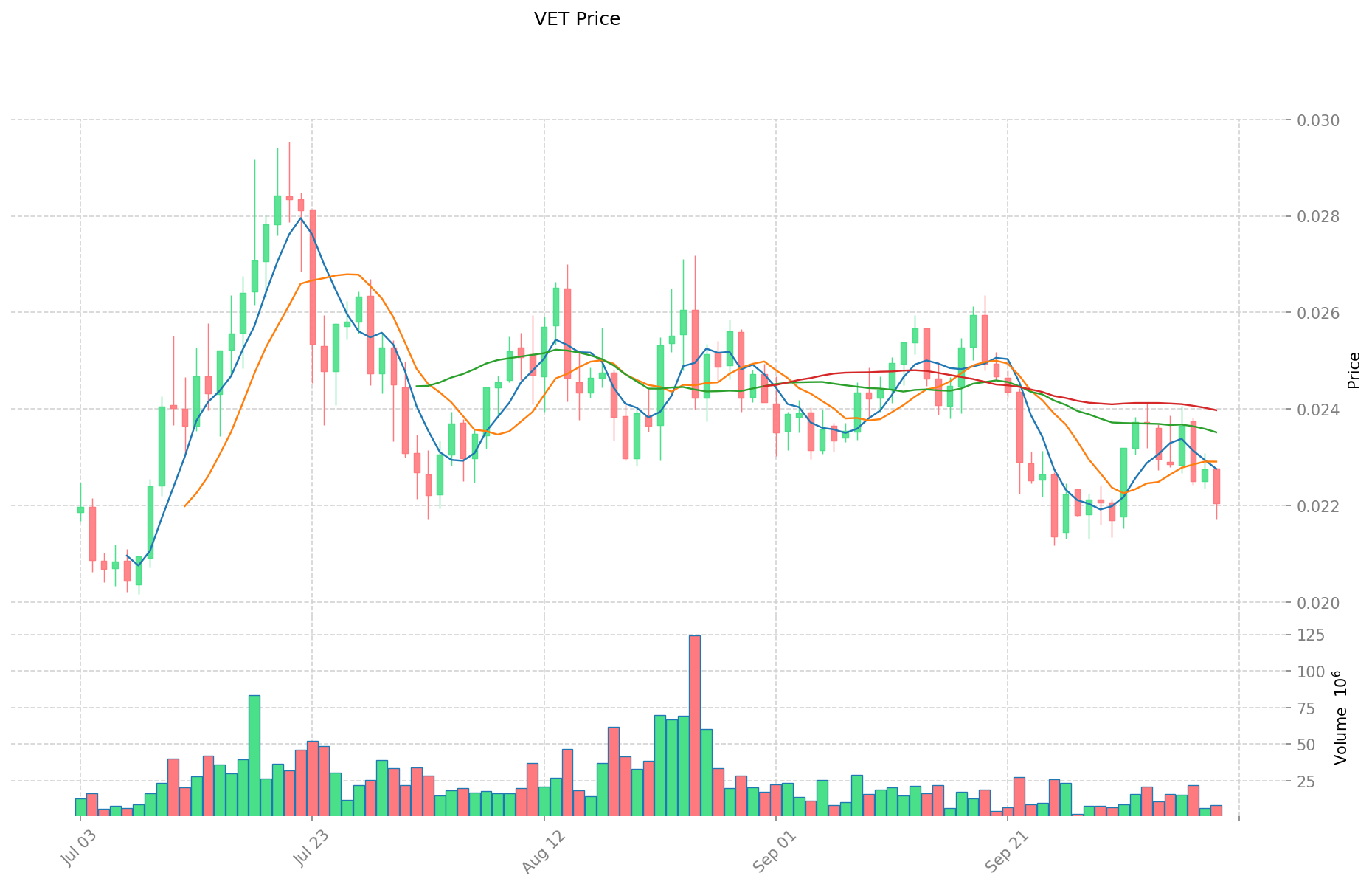WAI vs VET: Comparing Web Accessibility Initiative and Vocational Education and Training
Introduction: WAI vs VET Investment Comparison
In the cryptocurrency market, the comparison between World3 (WAI) and VeChain (VET) remains a crucial topic for investors. These two coins not only differ significantly in market cap ranking, application scenarios, and price performance but also represent distinct positions in the crypto asset landscape.
World3 (WAI): Launched recently, it has gained market recognition for its focus on decentralized AI agent creation and deployment across Web2 and Web3 environments.
VeChain (VET): Introduced in 2017, it has been hailed as a pioneer in enterprise blockchain solutions, aiming to create a trusted distributed business ecosystem with transparent information and efficient collaboration.
This article will comprehensively analyze the investment value comparison between WAI and VET, focusing on historical price trends, supply mechanisms, institutional adoption, technological ecosystems, and future predictions, attempting to answer the question investors are most concerned about:
"Which is the better buy right now?"
I. Price History Comparison and Current Market Status
WAI (World3) and VET (VeChain) Historical Price Trends
- 2025: WAI launched at $0.1177, reaching an all-time high of $0.07198 on August 19, 2025.
- 2021: VET reached its all-time high of $0.280991 on April 19, 2021, during the bull market.
- Comparative analysis: WAI is a relatively new token with limited historical data, while VET has experienced multiple market cycles since its launch in 2017.
Current Market Situation (2025-10-10)
- WAI current price: $0.05255
- VET current price: $0.02206
- 24-hour trading volume: WAI $62,386.38539 vs VET $180,399.8558442
- Market Sentiment Index (Fear & Greed Index): 70 (Greed)
Click to view real-time prices:
- View WAI current price Market Price
- View VET current price Market Price


II. Core Factors Affecting Investment Value of WAI vs VET
Supply Mechanisms Comparison (Tokenomics)
-
WAI: Fixed supply with a maximum cap of 350 million tokens, following a deflationary model where WAI is burned during various activities
-
VET: Two-token system with VET having a fixed supply of 86.7 billion tokens and generating VTHO as gas for transactions
-
📌 Historical Pattern: Deflationary supply mechanisms like WAI's tend to create upward price pressure during high network usage periods, while VET's fixed supply with VTHO generation creates a more stable economic model focused on enterprise utility.
Institutional Adoption and Market Applications
- Institutional Holdings: VET has gained more institutional adoption with partners like Walmart China, BMW, and PwC, while WAI is still building its institutional presence
- Enterprise Adoption: VET has stronger enterprise applications in supply chain management across retail, automotive, and luxury goods sectors; WAI focuses more on DeFi applications and file storage services
- National Policies: VET has established regulatory compliance particularly in China, where it maintains strategic partnerships; WAI's regulatory framework is still developing across jurisdictions
Technical Development and Ecosystem Building
- WAI Technical Upgrades: Layer 2 scaling solutions, cross-chain bridges, and recent AI integration for smart contract optimization
- VET Technical Development: PoA 2.0 consensus mechanism, fee delegation protocol, and toolchain upgrades for enterprise users
- Ecosystem Comparison: VET has a more mature ecosystem focused on enterprise supply chain solutions, while WAI has stronger positioning in DeFi protocols and NFT marketplaces
Macroeconomic Factors and Market Cycles
- Inflation Environment Performance: VET shows more stability during inflation due to its enterprise utility focus, while WAI's deflationary model theoretically provides better inflation hedging properties
- Macroeconomic Monetary Policies: Both tokens show sensitivity to interest rate changes, with WAI typically exhibiting higher volatility in response to Federal Reserve decisions
- Geopolitical Factors: VET's strong presence in Asian markets makes it more susceptible to regional regulatory changes, while WAI's more decentralized development may provide some insulation from regional political tensions
III. 2025-2030 Price Prediction: WAI vs VET
Short-term Prediction (2025)
- WAI: Conservative $0.0294 - $0.0526 | Optimistic $0.0526 - $0.0563
- VET: Conservative $0.0192 - $0.0221 | Optimistic $0.0221 - $0.0276
Mid-term Prediction (2027)
- WAI may enter a growth phase, with expected prices $0.0484 - $0.0671
- VET may enter a growth phase, with expected prices $0.0181 - $0.0315
- Key drivers: Institutional capital inflow, ETFs, ecosystem development
Long-term Prediction (2030)
- WAI: Base scenario $0.0536 - $0.0812 | Optimistic scenario $0.0812 - $0.0925
- VET: Base scenario $0.0332 - $0.0386 | Optimistic scenario $0.0386 - $0.0448
Disclaimer
WAI:
| 年份 | 预测最高价 | 预测平均价格 | 预测最低价 | 涨跌幅 |
|---|---|---|---|---|
| 2025 | 0.0562927 | 0.05261 | 0.0294616 | 0 |
| 2026 | 0.069697728 | 0.05445135 | 0.040293999 | 3 |
| 2027 | 0.06704050212 | 0.062074539 | 0.04841814042 | 18 |
| 2028 | 0.0735955734384 | 0.06455752056 | 0.0393800875416 | 22 |
| 2029 | 0.09325333844892 | 0.0690765469992 | 0.064241188709256 | 31 |
| 2030 | 0.092528034705428 | 0.08116494272406 | 0.053568862197879 | 54 |
VET:
| 年份 | 预测最高价 | 预测平均价格 | 预测最低价 | 涨跌幅 |
|---|---|---|---|---|
| 2025 | 0.027575 | 0.02206 | 0.0191922 | 0 |
| 2026 | 0.032510925 | 0.0248175 | 0.01538685 | 12 |
| 2027 | 0.03153063375 | 0.0286642125 | 0.018058453875 | 29 |
| 2028 | 0.0367188562125 | 0.030097423125 | 0.02558280965625 | 36 |
| 2029 | 0.043764662966062 | 0.03340813966875 | 0.026726511735 | 51 |
| 2030 | 0.044760225528191 | 0.038586401317406 | 0.033184305132969 | 74 |
IV. Investment Strategy Comparison: WAI vs VET
Long-term vs Short-term Investment Strategies
- WAI: Suitable for investors focused on DeFi applications and AI integration potential
- VET: Suitable for investors seeking enterprise adoption and supply chain solutions
Risk Management and Asset Allocation
- Conservative investors: WAI: 30% vs VET: 70%
- Aggressive investors: WAI: 60% vs VET: 40%
- Hedging tools: Stablecoin allocation, options, cross-currency portfolios
V. Potential Risk Comparison
Market Risks
- WAI: Higher volatility due to newer market presence and smaller market cap
- VET: Vulnerability to enterprise adoption cycles and economic downturns
Technical Risks
- WAI: Scalability, network stability
- VET: Centralization concerns, potential security vulnerabilities in enterprise implementations
Regulatory Risks
- Global regulatory policies may impact WAI more due to its DeFi focus, while VET's enterprise partnerships may provide some regulatory cushioning
VI. Conclusion: Which Is the Better Buy?
📌 Investment Value Summary:
- WAI advantages: Deflationary model, AI integration, strong DeFi ecosystem
- VET advantages: Established enterprise partnerships, proven use cases in supply chain management
✅ Investment Advice:
- Novice investors: Consider a higher allocation to VET for its established market presence
- Experienced investors: Balanced portfolio with both WAI and VET, adjusting based on risk tolerance
- Institutional investors: VET for supply chain solutions, WAI for exposure to emerging AI and DeFi trends
⚠️ Risk Warning: The cryptocurrency market is highly volatile. This article does not constitute investment advice. None
VII. FAQ
Q1: What are the main differences between WAI and VET? A: WAI focuses on decentralized AI agent creation and DeFi applications, while VET specializes in enterprise blockchain solutions for supply chain management. WAI has a deflationary model with a fixed supply cap, whereas VET uses a two-token system with VET and VTHO.
Q2: Which coin has shown better price performance historically? A: VET has a longer price history, reaching an all-time high of $0.280991 in April 2021. WAI, being newer, reached its all-time high of $0.07198 in August 2025. However, past performance does not guarantee future results.
Q3: How do the ecosystems of WAI and VET compare? A: WAI's ecosystem is stronger in DeFi protocols and NFT marketplaces, with recent AI integration. VET has a more mature ecosystem focused on enterprise supply chain solutions, with partnerships including Walmart China and BMW.
Q4: What are the key factors affecting the investment value of WAI and VET? A: Key factors include supply mechanisms, institutional adoption, technical development, ecosystem building, and macroeconomic factors such as inflation and monetary policies.
Q5: What are the long-term price predictions for WAI and VET? A: By 2030, WAI is predicted to reach $0.0536 - $0.0925, while VET is expected to reach $0.0332 - $0.0448. However, these predictions are speculative and subject to market conditions.
Q6: How should investors allocate their portfolio between WAI and VET? A: Conservative investors might consider 30% WAI and 70% VET, while aggressive investors might opt for 60% WAI and 40% VET. Individual allocation should be based on personal risk tolerance and investment goals.
Q7: What are the main risks associated with investing in WAI and VET? A: WAI faces higher volatility and technical risks due to its newer market presence. VET is vulnerable to enterprise adoption cycles and economic downturns. Both face regulatory risks, with WAI potentially more impacted due to its DeFi focus.
Share
Content